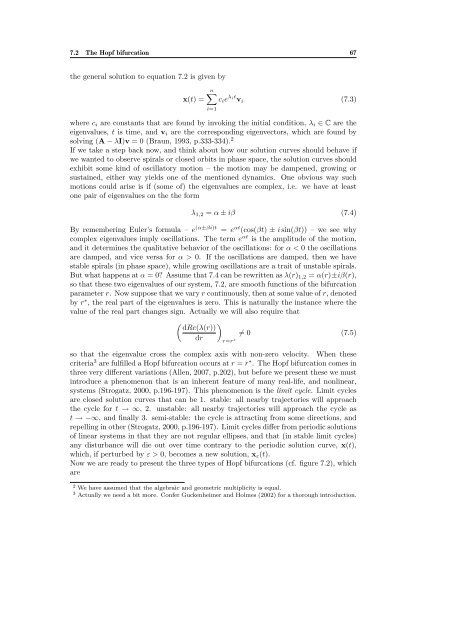nr. 477 - 2011 - Institut for Natur, Systemer og Modeller (NSM)
nr. 477 - 2011 - Institut for Natur, Systemer og Modeller (NSM)
nr. 477 - 2011 - Institut for Natur, Systemer og Modeller (NSM)
You also want an ePaper? Increase the reach of your titles
YUMPU automatically turns print PDFs into web optimized ePapers that Google loves.
7.2 The Hopf bifurcation 67<br />
the general solution to equation 7.2 is given by<br />
x(t) =<br />
n<br />
i=1<br />
cie λit vi<br />
(7.3)<br />
where ci are constants that are found by invoking the initial condition, λi ∈ C are the<br />
eigenvalues, t is time, and vi are the corresponding eigenvectors, which are found by<br />
solving (A − λI)v = 0 (Braun, 1993, p.333-334). 2<br />
If we take a step back now, and think about how our solution curves should behave if<br />
we wanted to observe spirals or closed orbits in phase space, the solution curves should<br />
exhibit some kind of oscillatory motion – the motion may be dampened, growing or<br />
sustained, either way yields one of the mentioned dynamics. One obvious way such<br />
motions could arise is if (some of) the eigenvalues are complex, i.e. we have at least<br />
one pair of eigenvalues on the the <strong>for</strong>m<br />
λ1,2 = α ± iβ (7.4)<br />
By remembering Euler’s <strong>for</strong>mula – e (α±βi)t = eαt (cos(βt) ± i sin(βt)) – we see why<br />
complex eigenvalues imply oscillations. The term eαt is the amplitude of the motion,<br />
and it determines the qualitative behavior of the oscillations: <strong>for</strong> α < 0 the oscillations<br />
are damped, and vice versa <strong>for</strong> α > 0. If the oscillations are damped, then we have<br />
stable spirals (in phase space), while growing oscillations are a trait of unstable spirals.<br />
But what happens at α = 0? Assume that 7.4 can be rewritten as λ(r)1,2 = α(r)±iβ(r),<br />
so that these two eigenvalues of our system, 7.2, are smooth functions of the bifurcation<br />
parameter r. Now suppose that we vary r continuously, then at some value of r, denoted<br />
by r∗ , the real part of the eigenvalues is zero. This is naturally the instance where the<br />
value of the real part changes sign. Actually we will also require that<br />
<br />
dRe(λ(r))<br />
= 0 (7.5)<br />
dr<br />
so that the eigenvalue cross the complex axis with non-zero velocity. When these<br />
criteria 3 are fulfilled a Hopf bifurcation occurs at r = r ∗ . The Hopf bifurcation comes in<br />
three very different variations (Allen, 2007, p.202), but be<strong>for</strong>e we present these we must<br />
introduce a phenomenon that is an inherent feature of many real-life, and nonlinear,<br />
systems (Str<strong>og</strong>atz, 2000, p.196-197). This phenomenon is the limit cycle. Limit cycles<br />
are closed solution curves that can be 1. stable: all nearby trajectories will approach<br />
the cycle <strong>for</strong> t → ∞, 2. unstable: all nearby trajectories will approach the cycle as<br />
t → −∞, and finally 3. semi-stable: the cycle is attracting from some directions, and<br />
repelling in other (Str<strong>og</strong>atz, 2000, p.196-197). Limit cycles differ from periodic solutions<br />
of linear systems in that they are not regular ellipses, and that (in stable limit cycles)<br />
any disturbance will die out over time contrary to the periodic solution curve, x(t),<br />
which, if perturbed by ε > 0, becomes a new solution, xε(t).<br />
Now we are ready to present the three types of Hopf bifurcations (cf. figure 7.2), which<br />
are<br />
2 We have assumed that the algebraic and geometric multiplicity is equal.<br />
3 Actually we need a bit more. Confer Guckenheimer and Holmes (2002) <strong>for</strong> a thorough introduction.<br />
r=r ∗
















